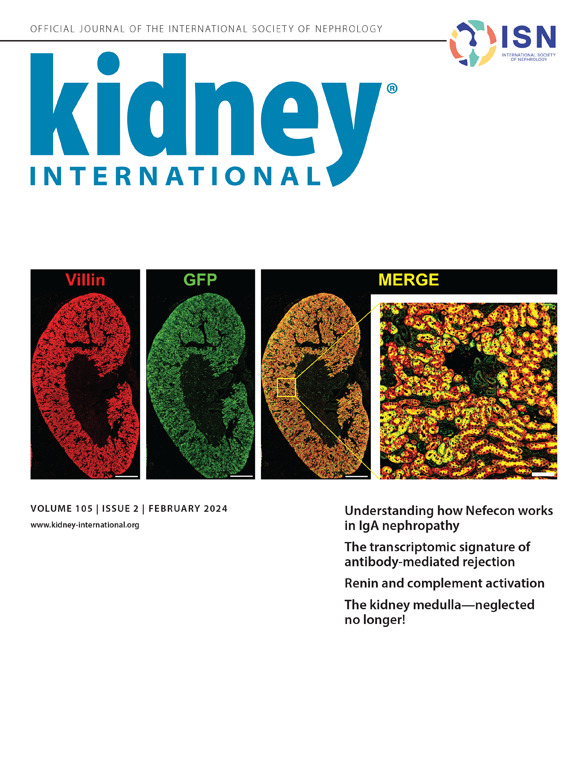The glomerular circadian clock temporally regulates basement membrane dynamics and the podocyte glucocorticoid response
IF 14.8
1区 医学
Q1 UROLOGY & NEPHROLOGY
引用次数: 0
Abstract
Kidney physiology shows diurnal variation, and a disrupted circadian rhythm is associated with kidney disease. However, it remains largely unknown whether glomeruli, the filtering units in the kidney, are under circadian control. Here, we investigated core circadian clock components in glomeruli, together with their rhythmic targets and modes of regulation. With clock gene reporter mice, cell-autonomous glomerular clocks which likely govern rhythmic fluctuations in glomerular physiology were identified. Using circadian time-series transcriptomic profiling, the first circadian glomerular transcriptome with 375 rhythmic transcripts, enriched for extracellular matrix and glucocorticoid receptor signaling ontologies, were identified. Subsets of rhythmic matrix-related genes required for basement membrane assembly and turnover, and circadian variation in matrix ultrastructure, coinciding with peak abundance of rhythmic basement membrane proteins, were uncovered. This provided multiomic evidence for interactions between glomerular matrix and intracellular time-keeping mechanisms. Furthermore, glucocorticoids, which are frequently used to treat glomerular disease, reset the podocyte clock and induce rhythmic expression of potential glomerular disease genes associated with nephrotic syndrome that included Nphs1 (nephrin) and Nphs2 (podocin). Disruption of the clock with pharmacological inhibition altered the expression of these disease genes, indicating an interplay between clock gene expression and key genes required for podocyte health. Thus, our results provide a strong basis for future investigations of the functional implications and therapeutic potential of chronotherapy in glomerular health and disease.

肾小球昼夜节律时钟在时间上调节基底膜动态和荚膜糖皮质激素反应。
肾脏生理机能呈现昼夜变化,昼夜节律紊乱与肾脏疾病有关。然而,肾小球是肾脏的过滤单元,它是否受昼夜节律控制在很大程度上仍是未知数。在这里,我们研究了肾小球中的核心昼夜节律时钟成分及其节律目标和调控模式。通过时钟基因报告小鼠,我们确定了可能控制肾小球生理节律波动的细胞自主肾小球时钟。利用昼夜节律时间序列转录组剖析,首次发现了具有375个节律转录本的昼夜节律肾小球转录组,这些转录本富含细胞外基质和糖皮质激素受体信号本体。发现了基质膜组装和周转所需的节律性基质相关基因子集,以及基质超微结构的昼夜节律变化,这些变化与节律性基质膜蛋白的丰度峰值相吻合。这为肾小球基质与细胞内计时机制之间的相互作用提供了多组学证据。此外,经常用于治疗肾小球疾病的糖皮质激素能重置荚膜细胞时钟,并诱导与肾病综合征相关的潜在肾小球疾病基因的节律性表达,这些基因包括 NPHS1(肾素)和 NPHS2(荚膜素)。药物抑制对时钟的干扰改变了这些疾病基因的表达,表明时钟基因表达与荚膜细胞健康所需的关键基因之间存在相互作用。因此,我们的研究结果为今后研究时间疗法在肾小球健康和疾病中的功能意义和治疗潜力奠定了坚实的基础。
本文章由计算机程序翻译,如有差异,请以英文原文为准。
求助全文
约1分钟内获得全文
求助全文
来源期刊

Kidney international
医学-泌尿学与肾脏学
CiteScore
23.30
自引率
3.10%
发文量
490
审稿时长
3-6 weeks
期刊介绍:
Kidney International (KI), the official journal of the International Society of Nephrology, is led by Dr. Pierre Ronco (Paris, France) and stands as one of nephrology's most cited and esteemed publications worldwide.
KI provides exceptional benefits for both readers and authors, featuring highly cited original articles, focused reviews, cutting-edge imaging techniques, and lively discussions on controversial topics.
The journal is dedicated to kidney research, serving researchers, clinical investigators, and practicing nephrologists.
 求助内容:
求助内容: 应助结果提醒方式:
应助结果提醒方式:


